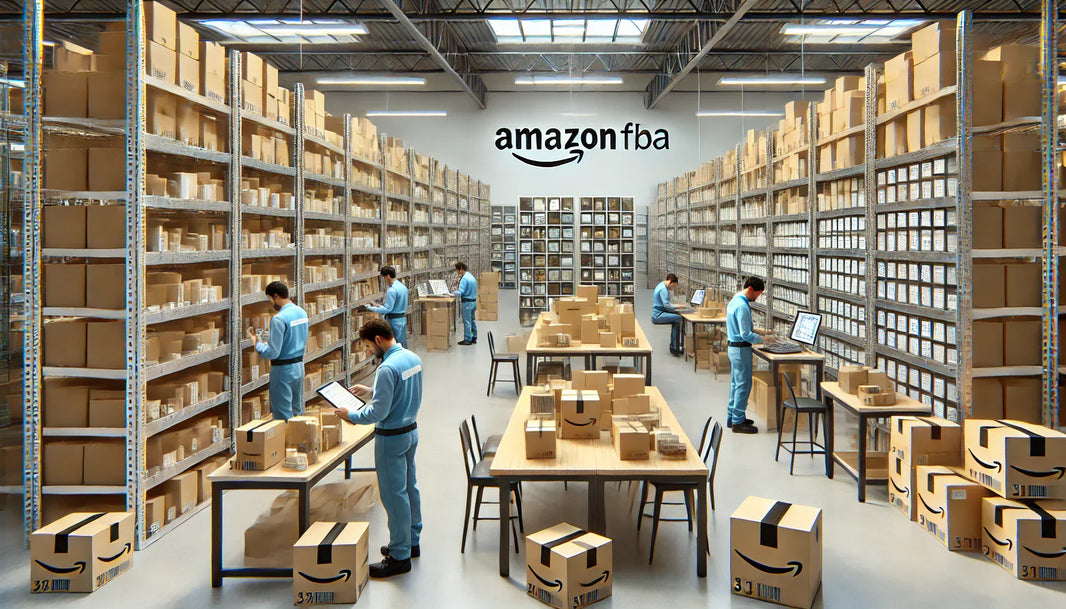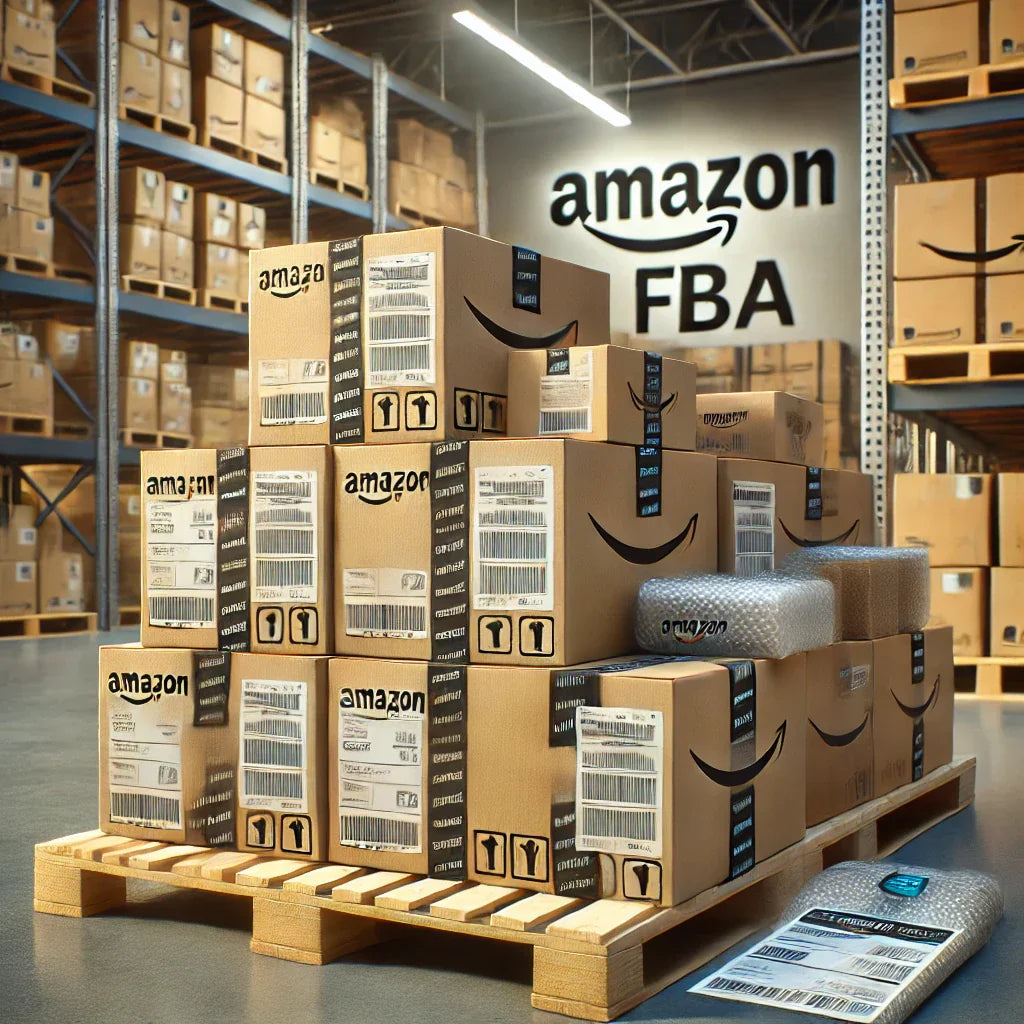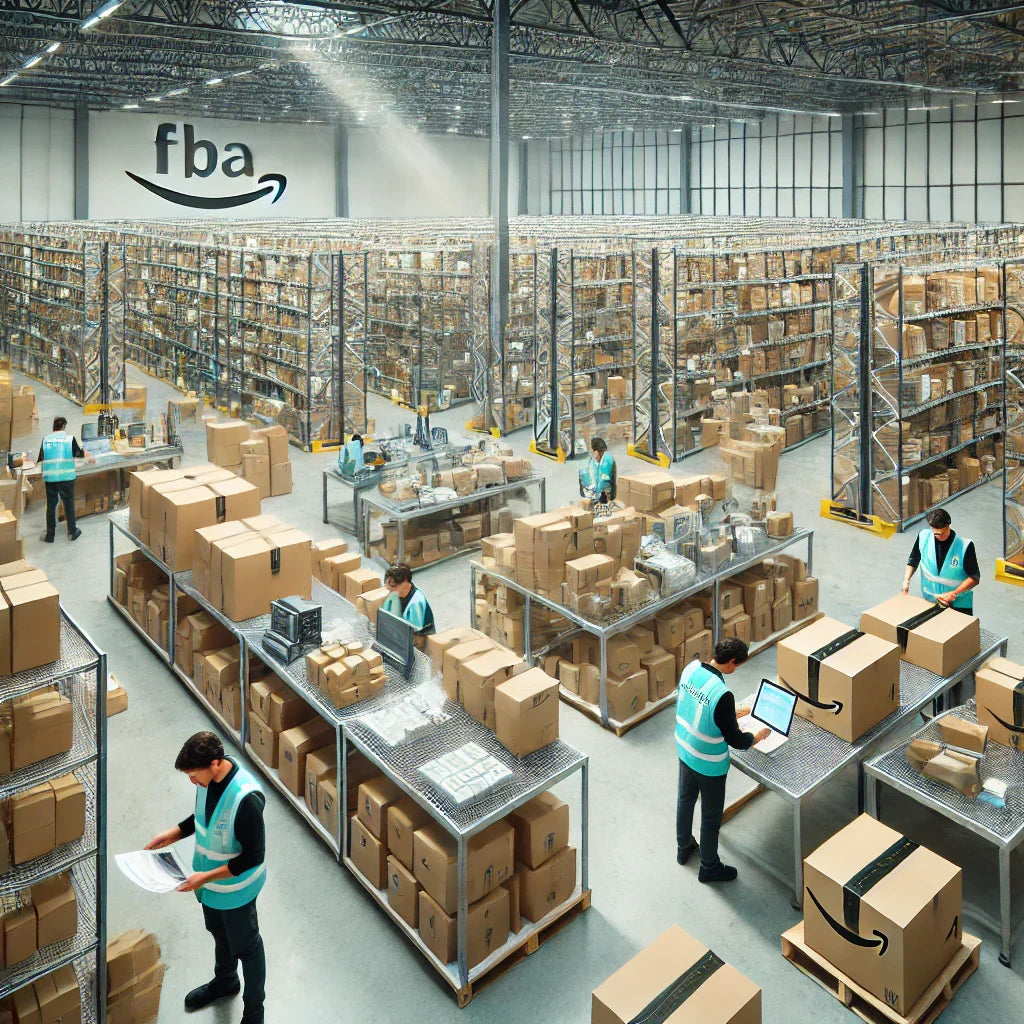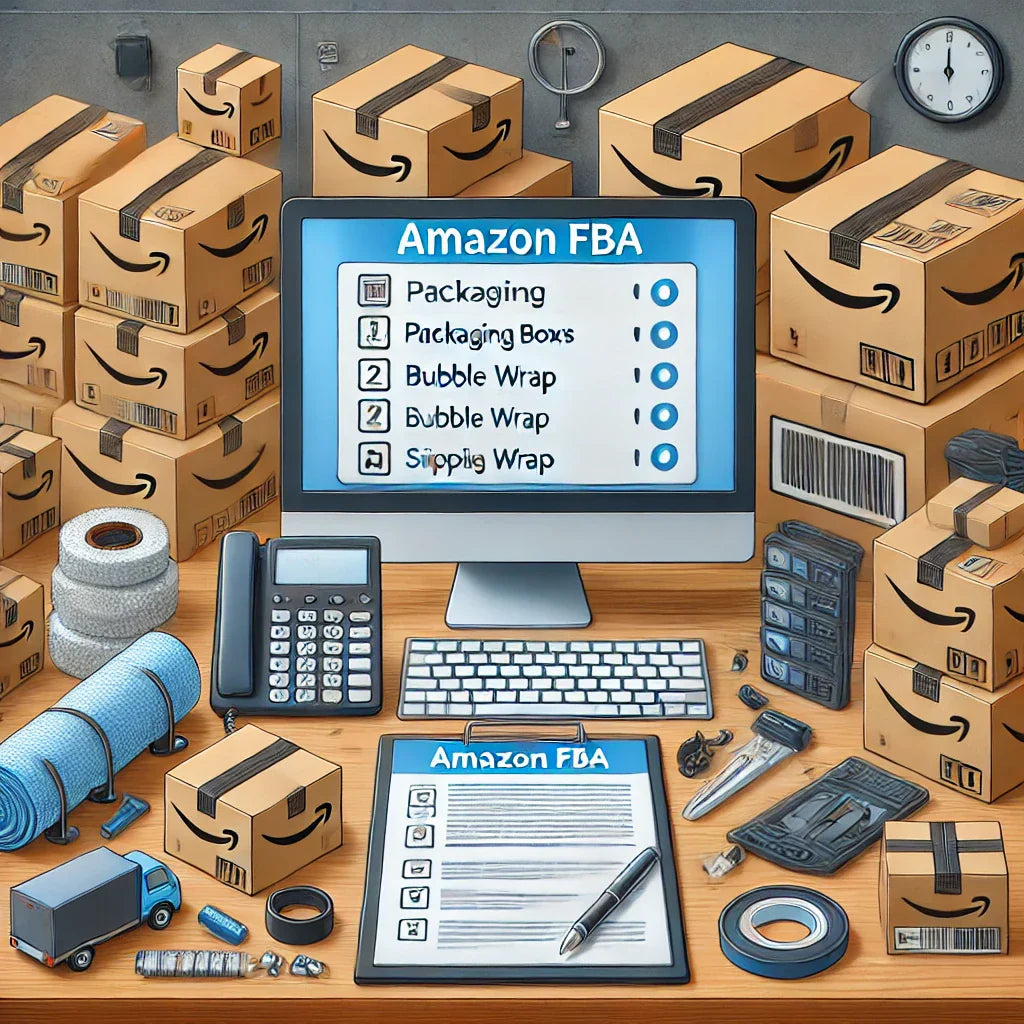As an Amazon seller, preparing your products for inbound shipment can be a pivotal step in ensuring a smooth journey from your warehouse to Amazon’s fulfillment centers. This process, known as inbound prep, plays a crucial role in maintaining product quality, reducing delays, and meeting Amazon’s stringent requirements. Understanding inbound prep not only enhances operational efficiency but also helps prevent common issues that can lead to costly mistakes or delays in product listings. In this guide, we'll walk you through the essentials of Amazon inbound prep, from packaging and labeling to compliance tips, providing everything you need to streamline your workflow and deliver a seamless experience for your customers.

1. What Is Inbound Prep for Amazon and Why Is It Important?
Inbound prep encompasses the steps required to prepare products for storage and sale within Amazon’s fulfillment centers, known as Fulfillment by Amazon (FBA) centers. For sellers, adhering to Amazon’s inbound prep standards is essential to ensure products arrive at FBA centers in a condition ready for immediate processing, storage, and eventual sale.
Amazon’s standards cover multiple areas:
- Packaging to prevent damage during transit
- Labeling to facilitate accurate tracking and inventory management
- Documentation to ensure all compliance requirements are met
Failure to comply with these requirements can lead to costly rework fees, delays, or even suspension of selling privileges. For sellers managing high volumes of inventory, these can significantly impact profitability.
Key Reasons to Prioritize Inbound Prep:
- Reduced Delays: Well-prepared products avoid unnecessary delays upon arrival.
- Lower Costs: Minimizing handling or rework fees by Amazon reduces overall expenses.
- Improved Customer Satisfaction: Ready-to-ship inventory ensures quick delivery and reduces the chances of damaged goods reaching customers.
By mastering the inbound prep process, Amazon sellers can foster a streamlined, cost-effective supply chain that supports long-term growth on the platform.
2. Key Elements of the Inbound Prep Process
To comply with Amazon’s inbound prep requirements, sellers must navigate several critical components. Below, we break down each stage of the process, providing best practices to ensure efficiency and compliance.
a. Packaging Standards
Amazon’s packaging standards aim to protect products during transit and storage. Ensuring your products meet these guidelines can prevent damage and reduce costly returns or replacements.
- Secure Packaging: Use materials such as bubble wrap, airbags, and sturdy boxes to protect products.
- Avoiding Loose Packaging: Items must be packaged in a way that prevents movement within the box. Loose items increase the risk of damage.
- Proper Box Sizes: Use boxes that fit snugly around products, limiting excess space and protecting the product.
Example: For fragile items, using padded poly bags or additional cushioning materials like foam inserts provides an added layer of protection.
b. Labeling Requirements
Correct labeling is vital for accurate inventory management within Amazon’s FBA network. Labels help Amazon track products efficiently, ensuring they reach customers without issues.
- Amazon Barcode Labels: Every product must have a scannable barcode (FNSKU) label on the exterior.
- Visibility: Place labels where they are easily scannable, avoiding edges or areas prone to wear and tear.
- Non-Amazon Labels: Remove any old barcodes, price stickers, or labels that might confuse Amazon’s scanning system.
Failure to label products correctly may result in items being incorrectly stored or shipped, leading to errors in order fulfillment and potential negative customer experiences.
c. Compliance with Amazon’s Product Restrictions
Amazon enforces specific restrictions on various product categories. Ensure you understand which restrictions apply to your products to avoid inbound delays or penalties.
- Hazardous Materials (Hazmat): Products containing chemicals or hazardous materials require special handling and may need approval before shipment.
- Restricted Categories: Certain items, such as perishables or adult products, have unique storage requirements and may not be eligible for FBA.
- Size and Weight Requirements: Following Amazon’s size and weight guidelines minimizes additional fees.
Researching Amazon’s guidelines on restricted items and consulting FBA resources can clarify any specific requirements applicable to your products.
3. Common Inbound Prep Mistakes and How to Avoid Them
Even experienced sellers can make errors in inbound prep that lead to costly consequences. Here are some of the most common pitfalls and strategies for avoiding them.
a. Incorrect Labeling
Failure to label products correctly can result in inventory mix-ups and shipment errors. Sellers often forget to remove old barcodes or misapply labels in ways that impede scanning.
Solution: Conduct a final check of all labels before shipment. Using a third-party prep service can be helpful for sellers with large inventories.
b. Inadequate Packaging
Inadequate packaging can lead to product damage during transit, leading to negative reviews and returns. Ensure each product is adequately padded and secure within its packaging.
Solution: Invest in high-quality packaging materials and conduct drop tests to assess durability.
c. Misunderstanding Amazon’s Product Restrictions
Amazon’s restricted product policies can be complex, leading some sellers to ship prohibited items inadvertently. Always verify that your product meets Amazon’s safety and category requirements before shipment.
Solution: Check Amazon’s guidelines for any new products you introduce to ensure compliance with current policies.
4. How to Choose the Right Inbound Prep Strategy for Your Business
Selecting the right approach to inbound prep depends on factors such as inventory volume, product complexity, and your team’s expertise. Here are three common strategies to consider:
a. In-House Prep
If you manage a relatively small inventory or have a dedicated team, performing inbound prep in-house can be cost-effective. However, it requires careful management and training to ensure consistent quality.
- Pros: Full control over processes and quality.
- Cons: Requires storage space, labor, and knowledge of Amazon’s guidelines.
b. Outsourcing to a Third-Party Prep Center
For sellers managing higher volumes or lacking dedicated prep staff, outsourcing to a third-party prep center may be beneficial. These centers handle all aspects of the prep process and ensure compliance with Amazon’s standards.
- Pros: Reduces operational burden and ensures compliance.
- Cons: Adds a per-unit cost, which can be high for small-margin items.
c. Using Amazon’s Prep Services
Amazon offers in-house prep services, allowing sellers to delegate certain tasks directly to Amazon. While convenient, Amazon’s prep services come at a cost and may not cover all specialized prep needs.
- Pros: Integrated into the FBA system, minimizing shipping complexity.
- Cons: Limited scope and relatively high cost.
Each option has unique benefits and drawbacks, so choose the one that best aligns with your operational needs and budget.
5. Steps to Efficiently Prepare Products for Amazon’s Inbound Requirements
An efficient inbound prep workflow helps reduce errors, speed up processes, and improve inventory accuracy. Here are the core steps to ensure success:
a. Organize Inventory
Organize products by SKU or category to streamline labeling and packaging. This organization speeds up the prep process and minimizes the risk of mistakes.
b. Batch Processing
Batch similar items together for packaging, labeling, and inspection. This method optimizes time management and reduces repetitive tasks.
c. Quality Control
Implement a quality control step to verify that all items are correctly packaged, labeled, and compliant with Amazon’s requirements before shipment.
d. Shipping and Documentation
Prepare necessary shipping documentation in advance to avoid delays. Be sure to track each shipment and use Amazon’s preferred carriers whenever possible.
Following these steps ensures that your products are ready for Amazon’s inbound process and minimizes the risk of errors that could impact customer satisfaction.
6. Using Amazon’s FBA Prep Service: Pros, Cons, and Costs
For sellers seeking a hands-off approach to inbound prep, Amazon’s FBA Prep Service can be a suitable option. Here’s a look at the benefits, potential drawbacks, and cost implications of using Amazon’s prep services.
a. Pros of Amazon’s FBA Prep Service
- Convenience: Amazon handles all prep steps, from labeling to packaging.
- Quality Assurance: Amazon’s in-house standards are high, ensuring reliable packaging and labeling.
b. Cons of Amazon’s FBA Prep Service
- Additional Fees: Amazon’s prep service fees can add up, especially for small-margin products.
- Limitations on Customization: Some products may require specialized prep that Amazon’s services cannot accommodate.
c. Costs of Using Amazon’s Prep Services
Amazon’s fees vary by product size, category, and specific prep requirements. Small items typically incur a lower fee, while larger items or those requiring special handling incur higher costs. Reviewing Amazon’s pricing and calculating the cost impact on your margins is essential before opting for these services.

7. Final Tips for Successful Inbound Prep on Amazon
Inbound prep is a critical component of maintaining an efficient and profitable Amazon business. Below are some final tips to ensure your success:
a. Stay Updated on Amazon’s Requirements
Amazon periodically updates its guidelines, so staying informed is crucial. Sign up for Amazon’s seller newsletters and regularly check Amazon’s Seller Central for updates.
b. Track and Optimize Your Process
Keep records of inbound shipments, noting any errors or delays that occur. Analyzing these records helps you identify areas for improvement and track costs associated with rework or prep services.
c. Consider Automation for High-Volume Orders
Investing in automated labeling, packaging, or inventory tracking systems can streamline processes for high-volume sellers and reduce the need for manual labor.
d. Regularly Assess Prep Costs
As your business grows, revisit your inbound prep strategy to ensure you’re using the most cost-effective approach. Scaling operations may call for a transition from in-house prep to third-party services or even a hybrid model.
8. Essential Tools for Inbound Prep Efficiency
When handling Amazon inbound prep in-house or through a third-party provider, utilizing the right tools can enhance efficiency, improve accuracy, and reduce the risk of mistakes. Let’s examine some essential tools for each stage of the inbound prep process.
a. Inventory Management Software
Inventory management software, such as SellerCloud, InventoryLab, or Skubana, helps track and organize stock levels, orders, and shipments. These tools offer robust reporting features that allow sellers to monitor product flow and identify trends over time.
- Benefits: Provides real-time inventory visibility, reduces stockouts, and aids in forecasting demand.
- Features to Look For: Multi-channel integration, real-time data sync with Amazon, customizable reporting, and barcode scanning.
b. Barcode and Label Printing Tools
Ensuring every product is accurately labeled is critical to Amazon’s requirements. Using barcode label printers, like the DYMO LabelWriter or Zebra printers, ensures high-quality, durable labels that meet Amazon’s standards.
- Benefits: Reduces the time spent manually labeling items and helps prevent issues due to unclear or faded labels.
- Features to Look For: High DPI (dots per inch) for clear printing, label customization, and thermal printing to reduce ink costs.
c. Packing and Shipping Equipment
Proper packing tools and materials are essential for inbound prep. Sellers should consider investing in items like automated packing stations, air cushion machines, and pallet jacks for efficient packing.
- Benefits: Speeds up packing and reduces the risk of damage to products.
- Key Tools: Packing stations with adjustable shelving, bubble wrap machines, and industrial scales for accurate shipping calculations.
d. Quality Control Checklists
A digital or printed quality control checklist helps ensure each product meets Amazon’s standards before it leaves the warehouse. Digital tools like Google Forms or specialized QC apps can help track compliance, allowing for easier oversight and training.
- Benefits: Minimizes mistakes and ensures consistency in packaging and labeling.
- Checklist Items: Label accuracy, packaging integrity, weight verification, and hazard compliance (if applicable).
Incorporating these tools into your inbound prep process allows for streamlined workflows and greater consistency, both of which are critical for Amazon’s FBA standards.
9. Understanding Amazon’s FNSKU Labeling
One of the most essential components of Amazon’s inbound prep process is the FNSKU (Fulfillment Network Stock Keeping Unit) labeling requirement. FNSKU labels are unique barcodes used by Amazon to track items through their network and ensure accurate inventory management.
a. What Is an FNSKU?
The FNSKU is a unique identifier that Amazon assigns to each product variation sold through FBA. Unlike UPC or EAN codes, the FNSKU is specific to Amazon and distinguishes each product variation based on the seller.
b. Applying FNSKU Labels Correctly
Each product sold through FBA must have an FNSKU label applied in a visible, scannable area. This label replaces any other barcodes, such as a manufacturer’s UPC or EAN, which must be removed to prevent scanning errors.
- Label Placement: Apply the FNSKU label on a flat, visible area of the packaging. Avoid placing labels on edges, corners, or uneven surfaces.
- Multiple Units in Packaging: If a single package contains multiple units (e.g., a box of pens), each unit must have an individual FNSKU label.
c. Common FNSKU Mistakes to Avoid
Failing to properly label products with FNSKUs can lead to significant delays or rework fees. Common errors include using incorrect label formats, applying the label over box seams, or failing to remove other barcodes.
To prevent these issues, double-check that all products have FNSKU labels correctly applied and that they adhere strictly to Amazon’s guidelines. This step ensures that each product is accurately tracked and processed by Amazon’s systems.
10. How to Ensure Product Compliance with Amazon’s Prep Requirements
Product compliance is a critical component of inbound prep, especially for items with specific handling requirements or restrictions. Ensuring compliance not only helps products pass Amazon’s quality checks but also minimizes risk of damage or rejection.
a. Hazardous Materials (Hazmat) Compliance
Certain products, like those containing lithium batteries, aerosols, or flammable materials, fall under Amazon’s hazardous materials restrictions. Sellers must complete Amazon’s Hazmat review process and secure approval before shipping these items.
- Hazmat Documentation: Prepare a Safety Data Sheet (SDS) for products classified as hazardous.
- Proper Labeling and Packaging: Follow Amazon’s guidelines for labeling and secure packaging for hazardous items to reduce transit risks.
b. Temperature-Controlled Items
Products like perishables, cosmetics, or items sensitive to temperature must meet specific requirements for storage and transit. Failure to comply with these requirements can lead to product spoilage or damage.
- FBA Requirements: Ensure products are shipped and labeled according to Amazon’s standards for temperature-controlled items.
- Packaging Guidelines: Use insulated containers and ice packs for temperature-sensitive items when appropriate.
c. Avoiding Prohibited Products
Amazon restricts the sale of certain items, such as live animals, illegal drugs, and medical devices. Sellers must thoroughly review Amazon’s restricted products policy to avoid shipping items that are banned from the platform.
Reviewing Amazon’s restricted product list and understanding category-specific requirements helps sellers avoid costly mistakes and potential account suspensions.
11. Managing High-Volume Inventory Inbound Prep for Amazon
For high-volume sellers, efficiently managing inbound prep for thousands of units requires both organization and scalability. Below are some strategies for optimizing inbound prep in a high-volume setting.
a. Implementing Batch Processing Techniques
Batch processing allows sellers to handle large quantities of similar items in one go, maximizing efficiency. This technique is especially useful for labeling, packaging, and quality control.
- Benefits: Reduces handling time per item, minimizes errors, and optimizes resource use.
- Tips: Group similar SKUs together and use dedicated stations for labeling, packaging, and inspection.
b. Partnering with Third-Party Logistics (3PL) Providers
Many high-volume sellers partner with 3PL providers to manage warehousing and prep services. 3PL providers offer dedicated resources and expertise to handle inbound prep and shipping to Amazon’s FBA centers.
- Advantages of 3PLs: Access to large-scale operations, reduced need for in-house warehousing, and improved shipping logistics.
- Selecting a 3PL: Choose a provider with Amazon FBA expertise to ensure they understand Amazon’s prep and compliance requirements.
c. Automating Repetitive Tasks
Automation tools, such as conveyor belt systems or robotic pick-and-place technology, can streamline inbound prep tasks for high-volume sellers. Automated solutions reduce manual labor costs and minimize human error.
For high-volume sellers, balancing automation, batching, and third-party support ensures that inbound prep remains efficient, accurate, and scalable as order volumes increase.
12. Analyzing and Reducing Inbound Prep Costs
Keeping track of costs associated with inbound prep can be challenging, particularly for high-volume sellers. By analyzing inbound prep expenses, sellers can make strategic decisions to improve cost efficiency.
a. Tracking Inbound Prep Expenses
Using tools like spreadsheets or inventory management software can help track each aspect of inbound prep costs, including packaging materials, labor, and transportation fees.
b. Reducing Labor Costs Through Efficient Training
For sellers performing inbound prep in-house, proper training can greatly reduce labor costs. Ensuring that team members understand Amazon’s guidelines and can complete tasks efficiently reduces time spent on rework.
- Training Tips: Conduct regular refresher training sessions, and create a resource library for Amazon’s FBA requirements to support team members.
c. Choosing Cost-Effective Packaging Solutions
Packaging costs can quickly add up, particularly for fragile or bulky products. Selecting durable yet affordable materials can help reduce costs without compromising product safety.
- Cost-Saving Tips: Source materials in bulk from reputable suppliers, use recyclable materials where possible, and invest in automated packaging solutions for high-volume needs.
Regularly reviewing inbound prep costs and identifying areas for improvement ensures that inbound prep remains both efficient and cost-effective.

13. Leveraging Seasonal Trends in Inbound Prep for Amazon
Seasonal trends, such as holiday sales or peak shopping periods, can greatly impact inbound prep volumes and costs. By preparing in advance for these fluctuations, sellers can minimize stress, reduce errors, and meet demand effectively.
a. Preparing for Holiday Sales
Holiday seasons often bring a significant increase in orders, requiring enhanced inbound prep efforts. Sellers should ramp up their inbound prep operations well before the holiday season to avoid delays.
- Planning Tips: Begin prepping holiday inventory at least 2-3 months before major shopping events like Black Friday or Christmas. Ensure adequate stock levels to meet demand and avoid stockouts.
b. Managing Back-to-School and Other Seasonal Demand
Different times of year can bring unique demands based on product category. For instance, back-to-school shopping impacts sellers of school supplies, electronics, and apparel.
- Strategies: Monitor seasonal trends in advance and adjust inbound prep volume to align with anticipated demand. Track historical data to make accurate demand forecasts.
c. Flexible Staffing and Resources
During peak seasons, scaling staff or resources temporarily can help manage the increased inbound prep workload without overextending regular employees.
Properly planning for seasonal fluctuations ensures that sellers maintain consistent inbound prep quality and meet demand spikes without compromising efficiency.
14. Developing a Long-Term Inbound Prep Strategy
While understanding the basics of inbound prep is essential, developing a long-term strategy is key to maintaining efficient and profitable operations on Amazon. This includes regularly assessing processes, costs, and resources.
a. Conducting Regular Process Reviews
Regularly reviewing your inbound prep processes allows you to identify inefficiencies or areas for improvement. This is especially important for sellers experiencing
14. Developing a Long-Term Inbound Prep Strategy
While understanding the basics of inbound prep is essential, developing a long-term strategy is key to maintaining efficient and profitable operations on Amazon. This includes regularly assessing processes, costs, and resources.
a. Conducting Regular Process Reviews
Regularly reviewing your inbound prep processes allows you to identify inefficiencies or areas for improvement. This is especially important for sellers experiencing rapid growth or fluctuating demand. Key aspects to review include:
- Packaging and Labeling Consistency: Ensure materials are consistently used to avoid product damage or barcode scanning issues.
- Labor Efficiency: Evaluate labor costs and time spent on prep tasks to see if there are areas where automation or outsourcing would save time and reduce expenses.
- Inventory Accuracy: Review inventory levels to ensure products are consistently stocked and that inbound shipments align with current demand projections.
Regular audits can highlight potential issues early, allowing you to address them before they impact your fulfillment speed or cost efficiency.
b. Setting Clear KPIs for Inbound Prep Performance
Establishing measurable performance indicators (KPIs) for inbound prep processes helps track progress over time. Some valuable KPIs to consider include:
- Inbound Error Rate: Measures the percentage of shipments that fail Amazon’s standards and require rework or incur additional fees.
- Processing Time Per Unit: Tracks the average time spent prepping each item, helping to identify time-consuming areas.
- Cost Per Unit: Monitors the cost associated with inbound prep per item, allowing you to track and reduce expenses.
Tracking these KPIs provides insight into how well your inbound prep strategy aligns with Amazon’s standards and where improvements may be needed as business scales.
c. Embracing Continuous Improvement
Inbound prep is not a one-time setup; it requires continuous monitoring and adaptation as your business evolves. Sellers should view inbound prep as a dynamic part of their operation and adjust processes based on changes in Amazon’s policies, advances in technology, and shifts in customer expectations.
- Stay Informed: Keep up to date on Amazon’s evolving requirements, including labeling, packaging, and restricted items.
- Encourage Feedback: Gather feedback from employees or third-party providers involved in the prep process to identify recurring challenges or bottlenecks.
- Adapt to Technology: Evaluate emerging technologies, like AI-based quality control or automated sorting, that could reduce errors or costs.
Embracing a mindset of continuous improvement helps ensure that your inbound prep strategy remains effective and scalable, even as your business adapts to new challenges and opportunities.
15. Key Compliance Considerations for Specific Product Categories
Amazon has additional requirements and restrictions for certain product categories, such as apparel, electronics, and consumables. Understanding these nuances is crucial to avoid penalties and ensure smooth inbound prep for specialized products.
a. Apparel and Textiles
Apparel and textiles have specific labeling and packaging guidelines to protect items and prevent damage during transit. Requirements for this category include:
- Poly Bag Requirements: Apparel items should be packaged in poly bags with clear suffocation warnings if the bag opening is larger than five inches.
- Folding and Tagging: Neatly fold clothing and affix any required tags, ensuring that items remain in a sale-ready condition.
- Transparent Packaging: Amazon recommends using transparent poly bags for easy identification and quality control during processing.
b. Electronics and Fragile Items
Electronics require specialized handling due to their high fragility and susceptibility to damage. Sellers should pay close attention to Amazon’s guidelines for these items:
- Cushioned Packaging: Use foam inserts, air pillows, or bubble wrap to protect electronics from shocks or vibrations during shipping.
- Anti-Static Packaging: Some electronic items require anti-static bags to prevent electrical damage.
- Battery Compliance: Electronics with batteries, especially lithium-ion batteries, must follow specific hazardous materials handling protocols and labeling requirements.
c. Consumables and Grocery Items
Grocery items and other consumables have their own set of requirements to ensure product safety and quality. Items in this category often require:
- Expiration Dates: Clearly label all products with expiration dates, formatted to meet Amazon’s standards (MM-DD-YYYY or MM-YYYY).
- Sealed Packaging: Ensure all consumables are tightly sealed to prevent contamination or spoilage.
- Temperature Control: Products sensitive to temperature fluctuations should be prepared in temperature-controlled environments to maintain freshness.
By addressing category-specific compliance, sellers can streamline the inbound prep process and avoid complications, such as product rejections or extra handling fees, that can delay product availability.
16. Sustainability in Inbound Prep: Strategies to Reduce Waste
As environmental responsibility becomes a priority for businesses and consumers alike, adopting sustainable inbound prep practices can enhance your brand image and reduce operational costs.
a. Eco-Friendly Packaging Options
Using sustainable packaging materials is a simple way to reduce waste. Consider switching to eco-friendly alternatives that offer the same level of protection for products without the environmental impact.
- Biodegradable Materials: Replace traditional bubble wrap or packing peanuts with biodegradable options like mushroom or cornstarch-based packaging.
- Recyclable Boxes and Labels: Use boxes made from recycled materials and opt for labels that can be easily removed or recycled.
- Right-Sizing Packaging: Avoid using oversized boxes that waste material. Choose packaging that snugly fits each product to reduce excess and improve shipping efficiency.
b. Reduce, Reuse, Recycle: A Three-Pronged Approach
The principles of reducing, reusing, and recycling are fundamental to sustainable practices. Integrating these steps into your inbound prep process can help minimize waste:
- Reduce: Streamline packaging processes to use only what is necessary for safe transit.
- Reuse: Use reusable containers for internal transport of items within the prep area.
- Recycle: Partner with recycling providers to ensure that all excess cardboard, plastic, and other materials are recycled properly.
c. Educate Your Team on Sustainable Practices
Training your team on sustainable practices encourages conscious decision-making that reduces waste at every stage of the prep process. This can include:
- Sustainability Workshops: Conduct workshops or training sessions on the importance of reducing waste and using eco-friendly materials.
- Recycling Stations: Set up recycling stations in the warehouse, clearly labeled for different types of materials.
- Incentivize Sustainable Choices: Recognize or reward team members who consistently use eco-friendly practices.
Sustainability in inbound prep not only benefits the environment but also creates a positive impression on customers who value eco-conscious businesses.
17. Tips for Efficient Documentation and Record-Keeping in Inbound Prep
Accurate documentation is essential for managing inbound prep effectively. Keeping detailed records streamlines audits, simplifies compliance, and makes troubleshooting easier in case of any issues with Amazon’s fulfillment process.
a. Digital Record-Keeping Tools
Using digital tools like spreadsheets or warehouse management software allows sellers to maintain organized records that are easily accessible and searchable.
- Software Options: Consider using Google Sheets, Microsoft Excel, or inventory-specific software like NetSuite or TradeGecko for centralized records.
- Data Tracking: Track essential data, such as product SKUs, lot numbers, and shipping dates, for easy reference and compliance.
b. Keeping Inbound Prep Logs
Inbound prep logs provide an additional layer of accountability, especially when multiple team members are involved in the prep process. A standard log might include:
- Date of Prep: Record the date each batch is prepared for shipment.
- Employee/Operator Name: Note the individual responsible for each batch, allowing for quality tracking.
- Checklist Completion: Confirm that all steps of the prep checklist were completed.
Logs can help identify inefficiencies, highlight training needs, and improve overall quality control by making employees accountable for their work.
c. Organizing Shipping and Compliance Documentation
Amazon requires documentation for many aspects of inbound shipments, particularly for items with specific compliance needs (e.g., hazardous materials). Keeping these documents well-organized simplifies the shipment process.
- Shipping Labels and FNSKU Labels: Maintain digital copies of all labels for easy reprinting if necessary.
- Compliance Certifications: For restricted items, keep documentation on file in case Amazon requests additional verification.
- Invoice and Inventory Tracking: Ensure each shipment is accounted for with accurate records of items included, quantities, and costs.
Detailed records and efficient documentation reduce delays, streamline audits, and enable better communication with Amazon’s support team if issues arise.

18. Planning for Future Growth in Amazon Inbound Prep
Planning for future growth ensures that your inbound prep process remains scalable as your business expands. Regularly reassessing and adjusting your prep operations is essential for continued success in Amazon’s fast-paced environment.
a. Forecasting Demand
One of the best ways to prepare for growth is to accurately forecast demand. Using sales data and historical trends, you can predict future sales volumes and proactively adjust inbound prep operations to meet expected demand.
- Sales Analysis: Evaluate seasonal trends and product performance to anticipate busy periods and adjust prep capacity accordingly.
- Inventory Projections: Maintain sufficient stock levels to avoid under- or over-stocking, which can increase holding costs and create bottlenecks.
b. Developing Scalable Prep Workflows
Scalable workflows ensure that inbound prep processes can grow with your business. This may involve adding new equipment, increasing staff, or redesigning workflow processes to handle higher volumes.
- Modular Workstations: Design workstations that can easily expand or adjust based on the current volume.
- Staff Training Programs: Implement cross-training programs to ensure staff can move between tasks as needed, reducing the reliance on specialized roles.
- Automating Repetitive Tasks: Automate repetitive tasks like barcode scanning or label printing to improve efficiency as order volumes increase.
c. Building Strategic Relationships with 3PLs
For sellers managing large inventories or multiple products, building partnerships with reliable third-party logistics (3PL) providers can alleviate inbound prep demands as your business grows.
- Choosing 3PL Partners: Look for providers with a strong understanding of Amazon’s inbound prep requirements. A reputable 3PL partner should offer services such as labeling, packaging, and inventory management specifically tailored to Amazon FBA needs.
- Defining Service-Level Agreements (SLAs): Set clear expectations with your 3PL regarding handling times, packaging standards, and communication protocols. SLAs help ensure that the 3PL’s performance aligns with your operational goals and Amazon’s standards.
- Evaluating Cost Efficiency: Regularly review the costs associated with outsourcing to a 3PL, including storage fees, handling charges, and transportation expenses. Compare these costs to in-house prep to ensure you’re choosing the most cost-effective solution as your business scales.
By strategically partnering with 3PLs, you can leverage their resources and expertise to manage high volumes of inventory efficiently, allowing you to focus on other aspects of business growth.
d. Expanding In-House Capabilities
For sellers preferring to maintain control over their inbound prep, investing in expanded in-house capabilities is essential for managing growth effectively. Here are some key areas for consideration:
- Warehouse Space: As your product catalog grows, consider leasing or purchasing additional warehouse space to accommodate increased inventory levels.
- Advanced Equipment: Investing in automated packing machines, conveyor belts, and barcode scanners can streamline workflows, reduce manual labor, and minimize errors.
- Scalable Systems: Implement robust inventory management and tracking software to handle increased SKUs and facilitate seamless integration with Amazon’s FBA systems.
Expanding in-house capabilities provides you with greater control over the quality and consistency of inbound prep processes, which can be particularly advantageous for high-value or sensitive products requiring specialized handling.
19. Integrating Technology for Enhanced Inbound Prep Efficiency
Technology plays a vital role in optimizing inbound prep for Amazon sellers, particularly as order volumes and complexity increase. By integrating technological solutions into your inbound prep process, you can improve efficiency, reduce errors, and create a scalable workflow.
a. Inventory Management Software (IMS)
Using inventory management software, such as Fishbowl, TradeGecko, or Zoho Inventory, simplifies the process of tracking products from arrival to shipment. IMS systems offer a range of tools to monitor stock levels, identify trends, and automate repetitive tasks.
- Centralized Data: IMS allows you to view real-time data on stock levels, incoming shipments, and product status across multiple locations.
- Automation of Key Processes: Automate tasks such as inventory counting, order updates, and low-stock alerts to streamline inbound prep and minimize stockouts.
- Integration with Amazon FBA: Some IMS options integrate directly with Amazon’s FBA system, facilitating seamless data sharing and inventory updates.
b. Barcode Scanning and Label Printing
Barcode scanners and label printers streamline the labeling process, reducing human error and speeding up operations. High-quality scanners, like Zebra or Honeywell models, paired with reliable label printers ensure accurate and durable labeling.
- Faster and Accurate Labeling: Barcode scanners reduce manual entry errors and ensure accurate tracking through Amazon’s network.
- Label Customization: Label printers, such as DYMO or Brother models, allow you to quickly produce FNSKU or other required labels in the precise format Amazon requires.
c. Automated Packing Systems
Automated packing systems enhance efficiency for high-volume sellers, particularly those handling fragile or complex items. These systems automate the packaging process, reducing the time and labor needed for manual packing.
- Custom Packing Solutions: Automated systems can be customized for specific product types, ensuring consistency and protection during transit.
- Reduced Packaging Waste: Many automated systems optimize packaging size and material use, reducing costs and environmental impact.
d. Data Analytics and Reporting Tools
Analytics tools, such as Tableau or Google Data Studio, allow sellers to analyze inbound prep data and make data-driven decisions. These insights enable better planning and optimization for future inbound shipments.
- Performance Tracking: Monitor KPIs such as prep times, error rates, and cost per unit to identify trends and areas for improvement.
- Forecasting and Demand Planning: Use analytics to predict demand patterns, ensuring that inbound prep aligns with sales forecasts and seasonal trends.
- Cost Management: Track expenses associated with packaging, labor, and shipping to pinpoint cost-saving opportunities.
By incorporating technology into inbound prep operations, Amazon sellers can create a more efficient, accurate, and scalable process that supports long-term growth and operational success.
20. Building a Resilient Inbound Prep Process for Long-Term Success
Inbound prep is a foundational aspect of running a successful Amazon business, and building a resilient process helps ensure operational continuity during periods of change or disruption.
a. Preparing for Seasonal Surges
Peak shopping seasons, like holidays, require a strategic approach to handle increased inbound prep demand. Planning ahead for these surges ensures that inventory levels remain stable, and shipments are processed smoothly.
- Stock Up Early: To avoid last-minute rushes, prepare seasonal inventory well in advance, typically two to three months ahead of peak periods.
- Increase Workforce Temporarily: Consider hiring seasonal staff or reallocating existing team members to inbound prep during high-demand periods.
- Pre-Schedule Inbound Shipments: Coordinate with Amazon’s FBA centers to pre-schedule shipments, ensuring they arrive in time for peak sales windows.
b. Implementing Contingency Plans
A resilient inbound prep process includes contingency plans to address potential disruptions, such as supply chain delays or unexpected demand increases.
- Backup Suppliers for Packaging Materials: Establish relationships with multiple suppliers to ensure availability of essential materials, such as boxes, bubble wrap, and labels.
- Flexible Shipping Options: Work with multiple carriers to provide alternative shipping solutions in case of delays or capacity issues with your primary provider.
- Inventory Buffer: Maintain an inventory buffer for high-demand products, particularly during peak periods, to avoid stockouts and allow for prep delays.
c. Training and Empowering Staff
A well-trained team is the backbone of a resilient inbound prep process. Providing ongoing training on Amazon’s requirements, as well as operational best practices, empowers employees to make decisions and address issues independently.
- Cross-Training Staff: Cross-train team members on various aspects of the prep process, so they can step into different roles as needed.
- Standard Operating Procedures (SOPs): Document SOPs for each step in the inbound prep process to ensure consistency and streamline onboarding for new team members.
- Encourage Proactive Problem-Solving: Train staff to identify potential issues early and take corrective action, reducing delays and minimizing rework.
d. Regular Review and Improvement Cycles
Building resilience means constantly evaluating and refining inbound prep processes. Regular review cycles allow sellers to incorporate new efficiencies and adapt to Amazon’s evolving standards.
- Quarterly Process Audits: Conduct audits every quarter to assess compliance with Amazon’s guidelines and identify areas for efficiency gains.
- Employee Feedback: Collect feedback from team members involved in inbound prep to gain insights into recurring challenges or areas for improvement.
- Stay Updated with Amazon’s Changes: Amazon occasionally updates FBA requirements; staying informed ensures that your processes remain compliant and efficient.

Conclusion
Mastering the inbound prep process is essential for Amazon sellers aiming to build a successful, scalable business within the competitive Amazon marketplace. By understanding and implementing Amazon’s packaging, labeling, and compliance requirements, sellers can minimize delays, reduce costs, and improve their product availability, directly enhancing customer satisfaction. Beyond these basics, embracing technology, monitoring KPIs, and continuously refining inbound prep practices allow sellers to adapt efficiently to changes in demand and Amazon’s evolving standards.
As businesses grow, investing in scalable solutions—whether through in-house improvements, strategic 3PL partnerships, or automation—ensures that operations remain smooth and resilient, even during peak seasons. With a well-organized, cost-effective, and resilient inbound prep strategy, Amazon sellers can maintain high standards, foster positive customer experiences, and focus on long-term growth and profitability on the platform.
Read More
- How to Optimize Inbound Prep for Amazon: Best Practices and Tips
- Understanding Amazon's Inbound Prep Requirements: A Step-by-Step Guide
- Inbound Prep Services for Amazon FBA: What Sellers Need to Know
- Common Mistakes in Amazon Inbound Prep and How to Avoid Them
- Amazon Inbound Prep: Streamlining Your Process for Faster Fulfillment
- Why Inbound Prep is Crucial for Amazon Success: An Overview for Sellers







